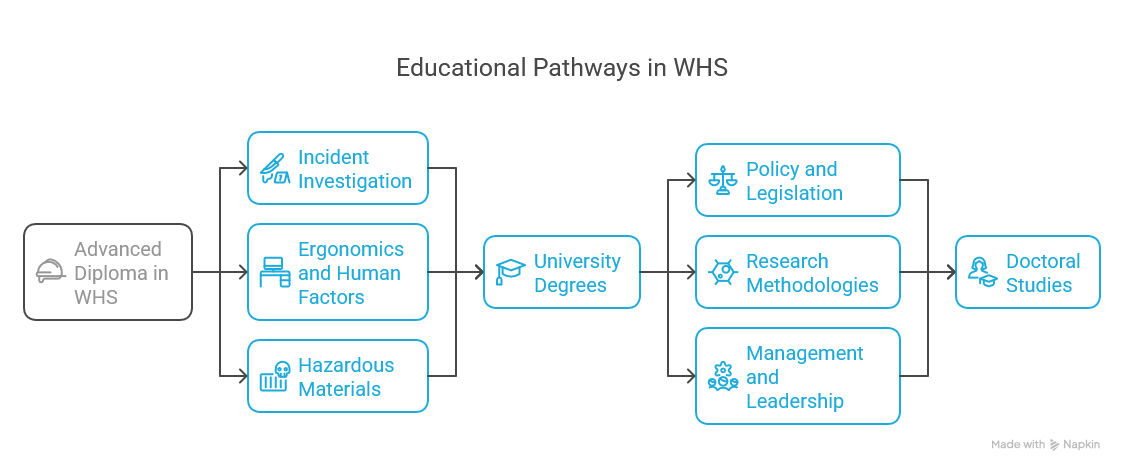Becoming a workplace health and safety (WHS) officer in Australia is an excellent career choice if you're passionate about safeguarding employees, preventing incidents, and meeting legislative requirements. While it's possible to drift into WHS responsibilities informally, most modern employers expect a formal qualification—often a BSB41419 Certificate IV in Work Health and Safety as a starting point. This article will guide you through the steps you need to take, complementing the topic, "How long does a Work Health and Safety Qualification take to complete?", where duration was the main focus.

Step 1: Assess Your Current Position
If you already handle some safety tasks—like conducting toolbox talks, filling out incident reports, or guiding risk assessments—you might be closer to WHS officer status than you think. This real-world experience can potentially count towards Recognition of Prior Learning (RPL) when you enrol in a formal course. However, if you're entirely new to WHS, you can still pursue a qualification and look for entry-level roles, such as WHS assistant or coordinator positions, to gain the necessary practical exposure.
Step 2: Choose the Right Qualification
Most aspiring WHS officers begin with the BSB41419 Certificate IV in Work Health and Safety, covering hazard identification, incident response, and compliance basics. This level of training ensures you understand Australia's legislative framework, including how Safe Work Australia influences nationwide standards and how state regulators enforce them.
After some experience, many professionals progress to the BSB51319 Diploma of Work Health and Safety, which delves into more advanced topics, including leadership in WHS, risk management systems, and strategic implementation of safety protocols. You might consider this upgrade if you're aiming for senior WHS roles or more competitive salaries.
Step 3: Gain Practical Experience
Hands-on experience is vital. While courses provide foundational knowledge, real workplaces present unique hazards and organisational cultures. Seek out opportunities to conduct safety audits, manage incident investigations, or lead safety training sessions. If you're studying, your RTO might require a practical project, allowing you to collaborate with a workplace or volunteer organisation to complete essential tasks for your assessments.
Step 4: Develop Essential Soft Skills
Being a WHS officer isn't just about technical expertise. Communication skills are paramount because you'll often persuade management to invest in safety measures or encourage frontline workers to follow protocols. You'll also need problem-solving abilities to adapt general safety guidelines to specific hazards. Building rapport with colleagues at all levels fosters a positive safety culture, ensuring that employees feel comfortable reporting hazards or incidents without fear of reprisals.
Step 5: Network and Stay Informed
Joining professional associations such as the Australian Institute of Health & Safety can enhance your career opportunities. These groups often host networking events, webinars, and workshops, and publish newsletters with the latest WHS developments. Regularly checking updates from Safe Work Australia or state regulators also keeps you abreast of legislative changes, emerging risks (like mental health and remote work), and evidence-based best practices.
Step 6: Maintain Currency
A formal qualification doesn't expire, but the knowledge can become outdated if you don't engage in continuous learning. Attend refresher courses, pursue short courses on specialised topics (like ergonomics or hazardous substance management), and explore advanced credentials if you aim to move into consultancy or managerial roles. Employers value candidates who show ongoing commitment to professional development.
Common Challenges and How to Overcome Them
- Resistance to Change: Workers may be skeptical of new safety measures. Building trust and explaining the rationale behind rules can help gain buy-in.
- Limited Budget: Some organisations may not prioritise WHS spending. Presenting cost-benefit analyses, including the potential savings from avoiding accidents, can sway decision-makers.
- Complex Legislation: WHS laws are comprehensive. Staying organised, using checklists, and consulting regulatory documents frequently helps avoid legal missteps.
Career Progression
Many WHS officers eventually move into senior advisor or manager roles. With the BSB51319 Diploma, you can oversee larger teams, conduct strategic audits, and shape company-wide policies. Some officers specialise in niche areas, like construction safety, psychological well-being, or industrial hygiene, often leading to higher earnings and more responsibility.
Becoming a workplace health and safety officer in Australia involves obtaining the right qualifications, gaining practical experience, honing communication skills, and continuously updating your knowledge. It's a career that requires dedication but offers the reward of actively contributing to safer, healthier workplaces.
If you have a genuine interest in protecting people and ensuring legal compliance, you'll find WHS a fulfilling and impactful field.